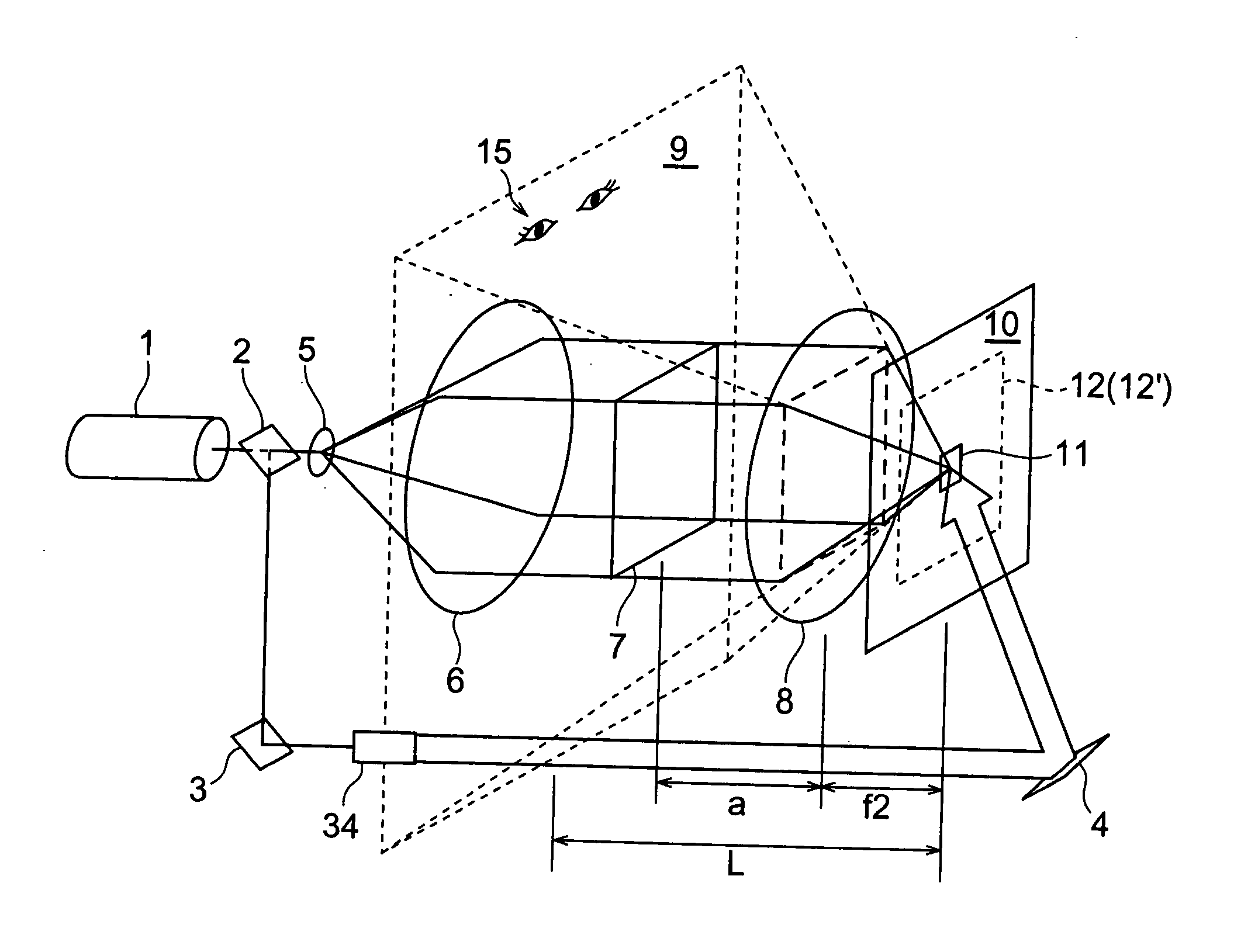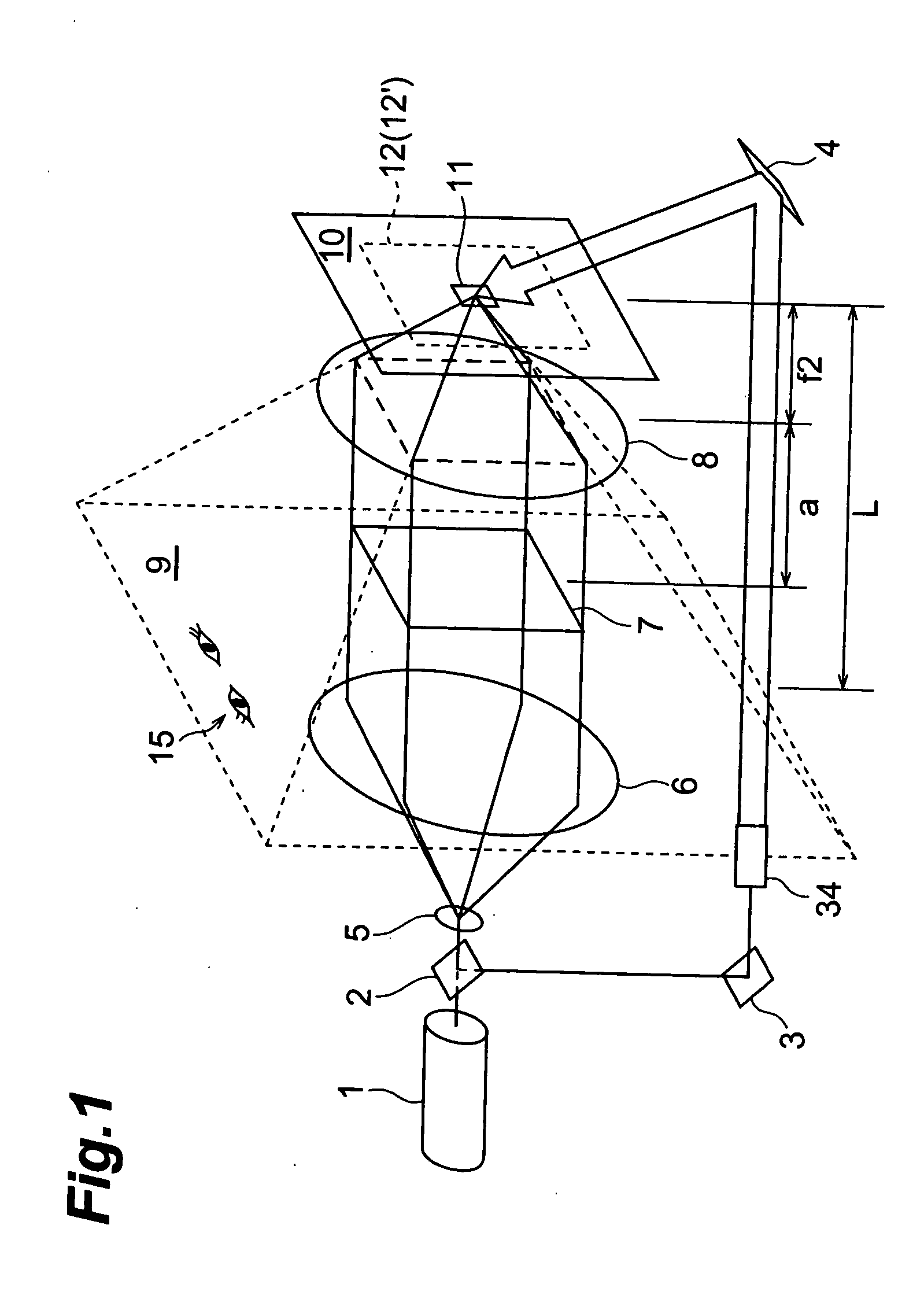Hologram making method
a hologram and making method technology, applied in the field of one-step type hologram making method, can solve the problems of substantial reduction, achieve the effects of improving uniformity and efficiency, uniform illumination, and reducing the angle of divergen
- Summary
- Abstract
- Description
- Claims
- Application Information
AI Technical Summary
Benefits of technology
Problems solved by technology
Method used
Image
Examples
first embodiment
[0039]FIG. 1 is an explanatory view of a hologram making apparatus equipped with an optical system in the case where an image of a spatial light modulating device is turned into a virtual image, whereas a viewpoint is placed at the virtual image position. This will be explained in detail in the following.
[0040] This apparatus comprises a laser light source (coherent light source; semiconductor laser) 1 emitting a laser beam having a single wavelength, and a half mirror 2 for splitting the laser beam emitted from the laser light source 1. The laser beams split by the half mirror 2 pass through (i) an object light irradiation optical system and (ii) a reference light irradiation optical system, thereby irradiating the surface (front face) and rear face of a photosensitive material 12, respectively.
[0041] (i) Object Light Irradiation Optical System
[0042] The object light irradiation optical system comprises a beam expander composed of lenses 5 and 6 arranged such that the light pass...
second embodiment
[0062]FIG. 2 is an explanatory view of a hologram making apparatus equipped with an optical system for turning an image of a spatial light modulating device into a real image while placing the viewpoint at the real image position. This apparatus is the same as that of the first embodiment except that the spatial light modulating device 7 is disposed on the light source side from the object-side focal position of the lens 8. In the same process as that mentioned above, a hologram 12′ is made from a photosensitive material 12 in this example.
[0063] In the case where a>f2 explained in this example, the light image emitted from the spatial light modulating device 7 at the time of making the hologram 12′ inherently forms an image at a position (referred to as real image position and indicated by the distance L′ from the hologram 12′ (photosensitive material 12)) farther distanced from the lens 8 than the image-side focal position of the lens by passing through the lens 8. Namely, the ob...
third embodiment
[0069]FIG. 3 is an explanatory view of a hologram making apparatus equipped with an optical system in the case where an image of a spatial light modulating device 7 is projected onto a diffuser screen′, and thus projected image is turned into a virtual image, whereas a viewpoint is placed at the virtual image position. In the apparatus in accordance with this embodiment, the diffuser screen 7′ is disposed at the position of the spatial light modulating device 7 in accordance with the first embodiment. This apparatus is configured such that the object light emitted from the spatial light modulating device 7 illuminated by a beam expander 5, 6 is projected onto the diffuser screen 7′ by way of an imaging lens PJ, in which the diffuser screen 7′ acts like the spatial light modulating device 7 described in the first embodiment. Namely, in this example, the spatial light modulating device 7 in the first embodiment is read as the diffuser screen 7′.
[0070] Since the spatial light modulati...
PUM
| Property | Measurement | Unit |
|---|---|---|
| size | aaaaa | aaaaa |
| size | aaaaa | aaaaa |
| size | aaaaa | aaaaa |
Abstract
Description
Claims
Application Information
 Login to View More
Login to View More - R&D
- Intellectual Property
- Life Sciences
- Materials
- Tech Scout
- Unparalleled Data Quality
- Higher Quality Content
- 60% Fewer Hallucinations
Browse by: Latest US Patents, China's latest patents, Technical Efficacy Thesaurus, Application Domain, Technology Topic, Popular Technical Reports.
© 2025 PatSnap. All rights reserved.Legal|Privacy policy|Modern Slavery Act Transparency Statement|Sitemap|About US| Contact US: help@patsnap.com



